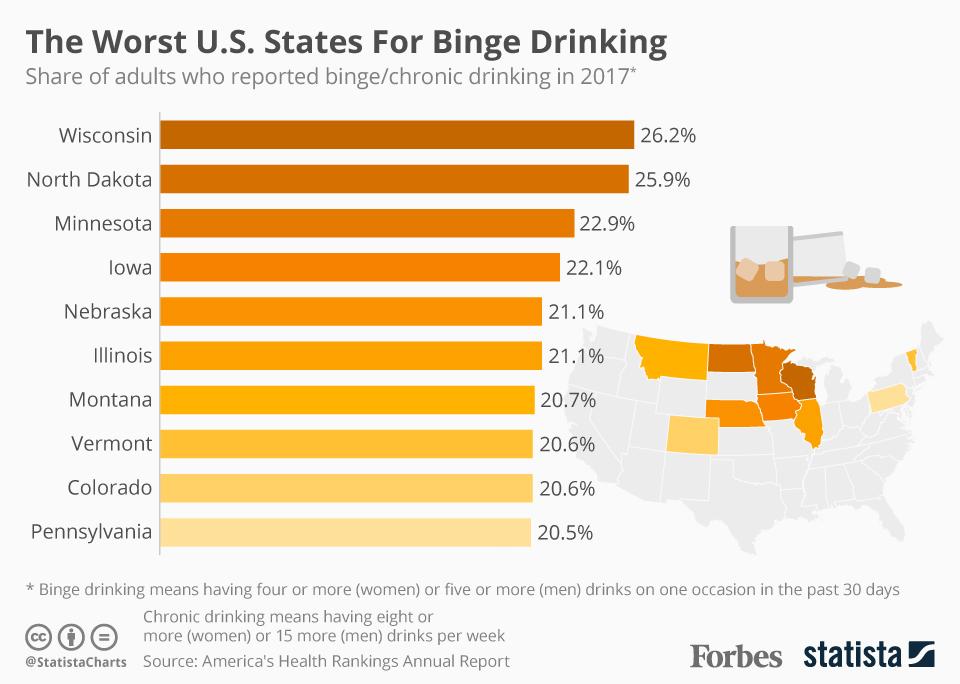ALCOHOL
Common Drug Names: juice, sauce, hooch, vino, liquid courage

Alcohol is the common term for ethanol or ethyl alcohol, a chemical substance found in alcoholic beverages such as beer, hard cider, malt liquor, wines, and distilled spirits (liquor). In the United States, a standard alcoholic drink contains 14 grams of pure alcohol (National Institute of Alcohol Abuse and Alcoholism). Generally, this amount is found in 12 ounces of beer, 8-9 ounces of malt liquor, 5 ounces of wine, or 1.5 ounces of liquor.
Alcohol has a strong effect on people; therefore, public health experts have developed guidelines to alcohol consumption. There is no safe level of consumption.
Moderation Guidelines
Level of Consumption
Moderate alcohol drinking
Heavy alcohol drinking
Binge drinking
Women
Up to 1 drink per day
4 or more drinks a day or 8+ in a week
4 or more drinks within 2 hours time (roughly)
Men
Up to 2 drinks per day
5 or more drinks a day or 15+ in a week
5 or more drinks within 2 hours time (roughly)
Drinking too much has a range of negative health impacts. Alcohol enters the bloodstream immediately upon consumption, and its effects appear within 10 minutes. As an individual’s blood alcohol concentration (BAC), which is the amount of alcohol present in the bloodstream, rises, that individual becomes more impaired. The effects include:
- Reduced inhibitions
- Slurred speech
- Motor impairment
- Confusion
- Memory problems
- Concentration problems
- Coma
- Breathing problems
- Death
Because of these impacts, drinking risks also include traffic/other accidents, risky behavior, violent behavior, suicide, and homicide.
In the long-term, drinking too much can lead to addiction. The physical health effects of addiction include heart damage (i.e. cardiomyopathy, arrhythmias, stroke, and hypertension), liver damage (i.e. fatty liver, alcoholic hepatitis, fibrosis, and cirrhosis), pancreas damage leading to pancreatitis (a dangerous inflammation of the blood vessels in the pancreas that prevents proper digestion), and immune system damage. According to the National Cancer Institute, there is also a strong correlation between alcoholism and head and neck cancer, esophageal cancer, liver cancer, breast cancer, and colorectal cancer.
Withdrawal is what occurs when a person suddenly stops drinking after prolonged and heavy alcohol use. Symptoms include trembling, hallucinations, insomnia, and anxiety. The most dangerous symptoms of withdrawal are seizures and delirium tremens.
Delirium tremens, which usually peaks at four to five days after the last drink, causes dangerous shifts in breathing, circulation, and temperature control. It can cause the heart to race, blood to increase, and dangerous dehydration. Delirium tremens can also temporarily reduce blood flow to the brain, causing confusion, disorientation, loss of consciousness, nervousness, angry behavior, irrational beliefs, soaking sweats, sleep disturbances, and hallucinations.
Signs of alcoholism or alcohol addiction include:
- Tolerance to alcohol; more drinking is required to achieve the same effect
- Withdrawal symptoms between bouts of drinking
- Loss of control over how much or often alcohol is consumed
- A wish to stop drinking but inability to follow through
- Laser-focus on alcohol leading to neglect of jobs, family, friends, and/or hobbies
- Continued alcohol use even though it leads to problems
Treatment for alcohol addiction often begins with an intervention in which family, friends, or other invested individuals help the person see the alcoholism as a problem and help motivate them to seek help. There are a variety of treatment options available, including both inpatient and outpatient programs. Recovery programs last anywhere from weeks to years and, due to the dangers of alcohol withdrawal, often begin with a medical detox. This is followed by a combination of therapy, support groups, and prescription medication. Relapse is not uncommon; according to the National Institute on Drug Abuse, 40-60% of individuals relapse. This provides an opportunity to refine the treatment programs to tailor it to the individual’s needs. People may need multiple rounds of rehab to make lasting changes.
SAMHSA's National Helpline - 1-800-662-HELP (4357)
SAMHSA’s National Helpline is a free, confidential, 24/7, 365-day-a-year treatment referral and information service (in English and Spanish) for individuals and families facing mental and/or substance use disorders.
SAMHSA's Behavioral Health Treatment Services Locator
Alcoholics Anonymous
Alcoholics Anonymous is a fellowship of people who come together to solve their drinking problem. It doesn’t cost anything to attend A.A. meetings. There are no age or education requirements to participate. Membership is open to anyone who wants to do something about their drinking problem. Find an AA meeting near you.
NIAAA's Alcohol Treatment Navigator
For Providers: Minnesota Alliance of Rural Addiction Treatment Programs
DRUG TRENDS
According to the Centers for Disease Control (CDC), more than 88,000 people die from alcohol-related deaths each year in the United States. Alcohol continues to be one of the nation’s most preventable causes of death, second only to tobacco and poor diet/sedentary lifestyle.

